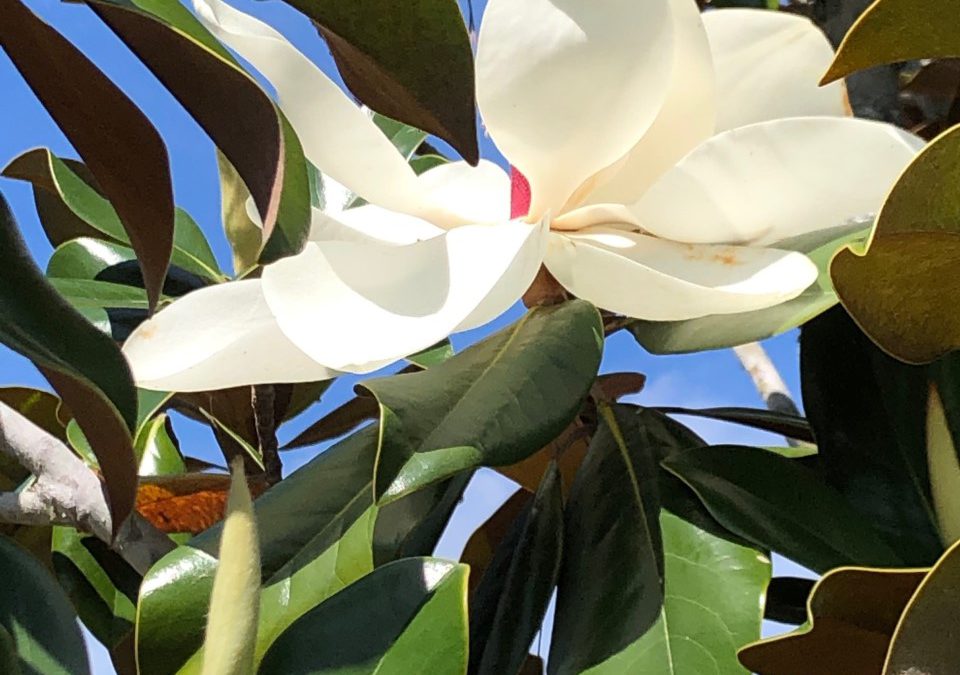
by Stephen Greer | Apr 15, 2021
There is a tall stately tree that can be found throughout the southeastern states, native in nature with a lustrous green leaf the southern magnolia is like no other tree. This amazing tree can be found from the edge of deep woodlands to the back of the tall sand dunes in the panhandle of Florida, all the way down the Florida Peninsula. The leaves provide a consistent evergreen providing a year-round presence in the landscape. Spring brings up small plate sized creamy white blooms with a wonderful fragrance with multiple blooms opening over 3 to 5 weeks. The magnolia can serve as a specimen tree or a back drop to allow other plants to be enjoyed.
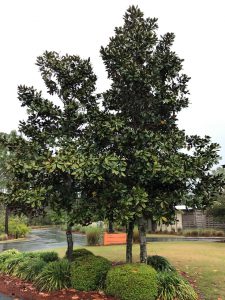
Magnolia Tree in the Landscape. Photo courtesy Stephen Greer
Often the magnolia is envisioned to be this 80-foot tall by 40-foot-wide tree with an upright pyramidal shape with the branches reaching to the ground and up to 8-inch-long shiny green leaves. There are other shapes and sizes in the landscape industry that have been found in many different ways from seedling research that has taken place at several of our land grant universities including the University of Florida. Other magnolia with different growth and bloom habits have been found growing in nature. Below are a few of these exceptional species that were selected by the keen eye of a nurseryman or a plant specialist. Next come decades of field grown observation to determine if the plant characteristics are consistent with cuttings taken and rooted to grow more trees. This is one way to see if the same look and growth continues in multiple plants.
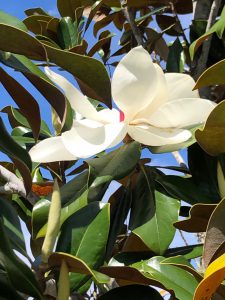
Magnolia Bloom. Photo courtesy Stephen Greer
If you grow trees from collected seeds, the new seedlings will show variable growth patterns and likely not present a consistent growth or leaf form from tree to tree. This is the reason for taking cuttings from a magnolia with the desired growth habit, leaf size and color, bloom color and fragrance.
Several cultivars have risen to the top in popularity in the landscape industry over the last 30 to 40 years. One of the most popular large magnolias is ‘Bracken’s Brown Beauty’. It was selected in a seedling field when one of the universities had completed research and invited a local nurseryman to come take any he wanted before the field was turned under for other plant research. Many were dug and field planted at the nursery with one showing many desired characteristics. With its dark rusty brown lower leaf and deep green top. It was observed for a number of years with cuttings taken. One major observation was its tolerance to cold weather. They had a winner and began to introduce it into the plant industry. ‘Little Gem’ is another magnolia that is quite popular for its dwarf (slower) upright growth habit. It first was considered a hedge plant with a dense leaf canopy from bottom to top. The challenge is the plant density opens up as it matures with it ultimately reaching approximately 30-foot tall by 20-foot wide. The surprising part of this smaller magnolia is its bloom is similar in number, yet 3 to 5 inches in size in large numbers as the other southern magnolias. Next there is a few weeks rest period and then sporadically blooms all summer and early fall. There are so many magnolias that could be mentioned I just don’t have enough article space, so it will stop with ‘Claudia Wannamaker’. This magnolia is an old stand by that has been found to be moderately salt tolerant and can be found growing near coastal settings. The leaf wax layer is slightly thicker allowing for a little more protection from the salt. It has a more open multi-truck growth allowing for wind to pass through more easily. The challenge is finding one in the landscape industry.
Contact your UF IFAS Extension office in your county with questions. Enjoy this wonderfully unique tree.
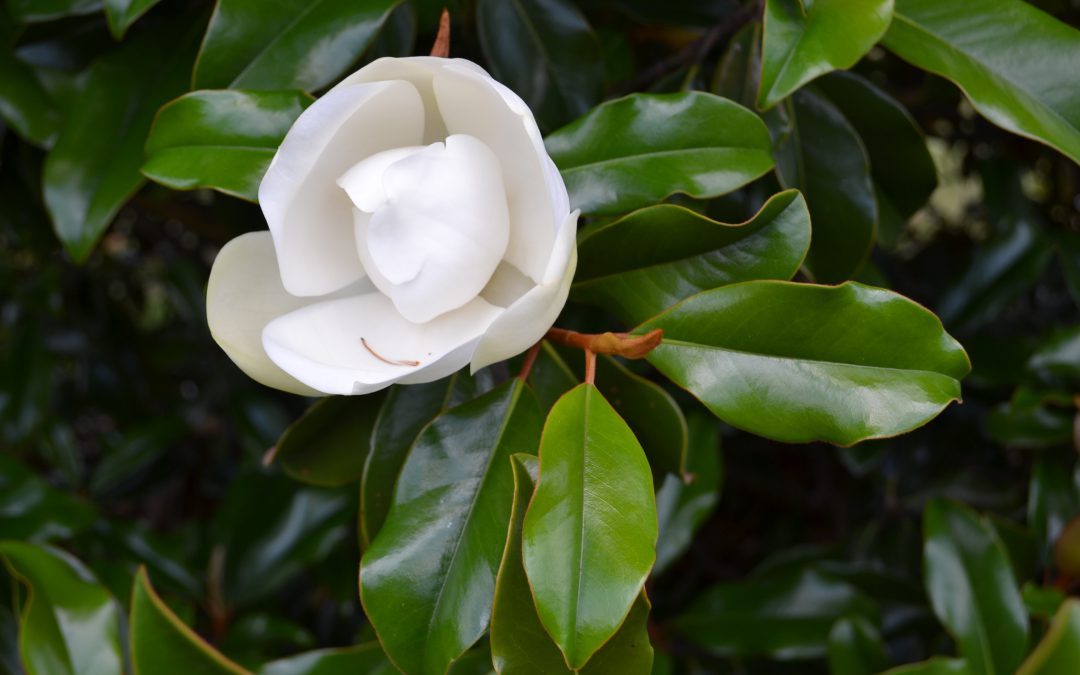
by Beth Bolles | Jan 13, 2020
The Southern magnolia (Magnolia grandiflora) has always been a favorite tree since it is associated with my childhood home in Tennessee. I always enjoyed the evergreen leaves and large white flowers. In my parent’s yard, the southern magnolia had branches to the ground that allowed the large leaves to stay hidden in a self- mulching area. I never recall the tree begin called messy because of this growth style.
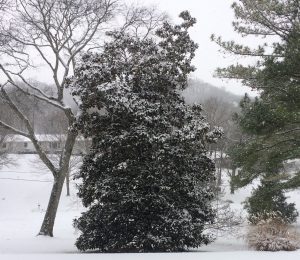
A Southern Magnolia in a Tennessee winter. Photo by Beth Bolles, UF IFAS Extension Escambia County
Many landscapes today may not have room for a southern magnolia that can grow an average of 60 feet in height with an average spread of 25 feet. Because it’ qualities are still desirable, nursery professionals have developed southern magnolia cultivars that are very popular as landscape features due to different growth habits, leaf sizes, and hardiness to our area’s weather. Although the cultivars will be different from the old favorite southern magnolia in growth form and size, homeowners should still do their homework to make sure trees are located in spots for plants to reach proper height and width growth. Also, like I mentioned for my parent’s tree, many of the new cultivars look best if the lower limbs are not removed.
If you or your landscaper are considering a Southern magnolia cultivar, here are a few details about some you may find available.
‘Little Gem’ dwarf southern magnolia has been the go-to magnolia for new landscapes. The dark green leaves are smaller and the plant will be more compact than the traditional southern magnolia. It is often misplaced in landscapes because of these features. Trees still grow about 25 feet high with a spread of 15 feet.
‘Bracken’s Brown Beauty’ is a very attractive magnolia when given room to grow. Foliage is very attractive with shiny green above and brown on the undersides. This plant can grow 40 to 50 feet in height with a spread averaging 20 feet. Plan not to prune lower limbs to maintain a beautiful form.
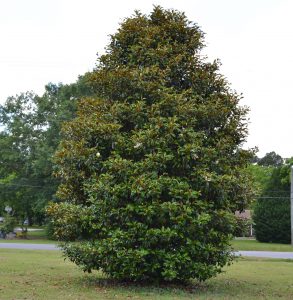
Bracken’s Brown Beauty as an accent tree in a lawn area. Photo by Beth Bolles, UF IFAS Extension Escambia County
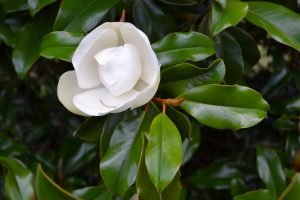
Bracken’s Brown Beauty flower. Photo by Beth Bolles, UF IFAS Extension Escambia County
‘Southern Charm’ magnolia, registered as Teddy Bear is also a compact plant. It grows upright to about 20 feet with a spread about 15. You still have the beautiful green and brown leaf color along with 6 inch wide flowers.
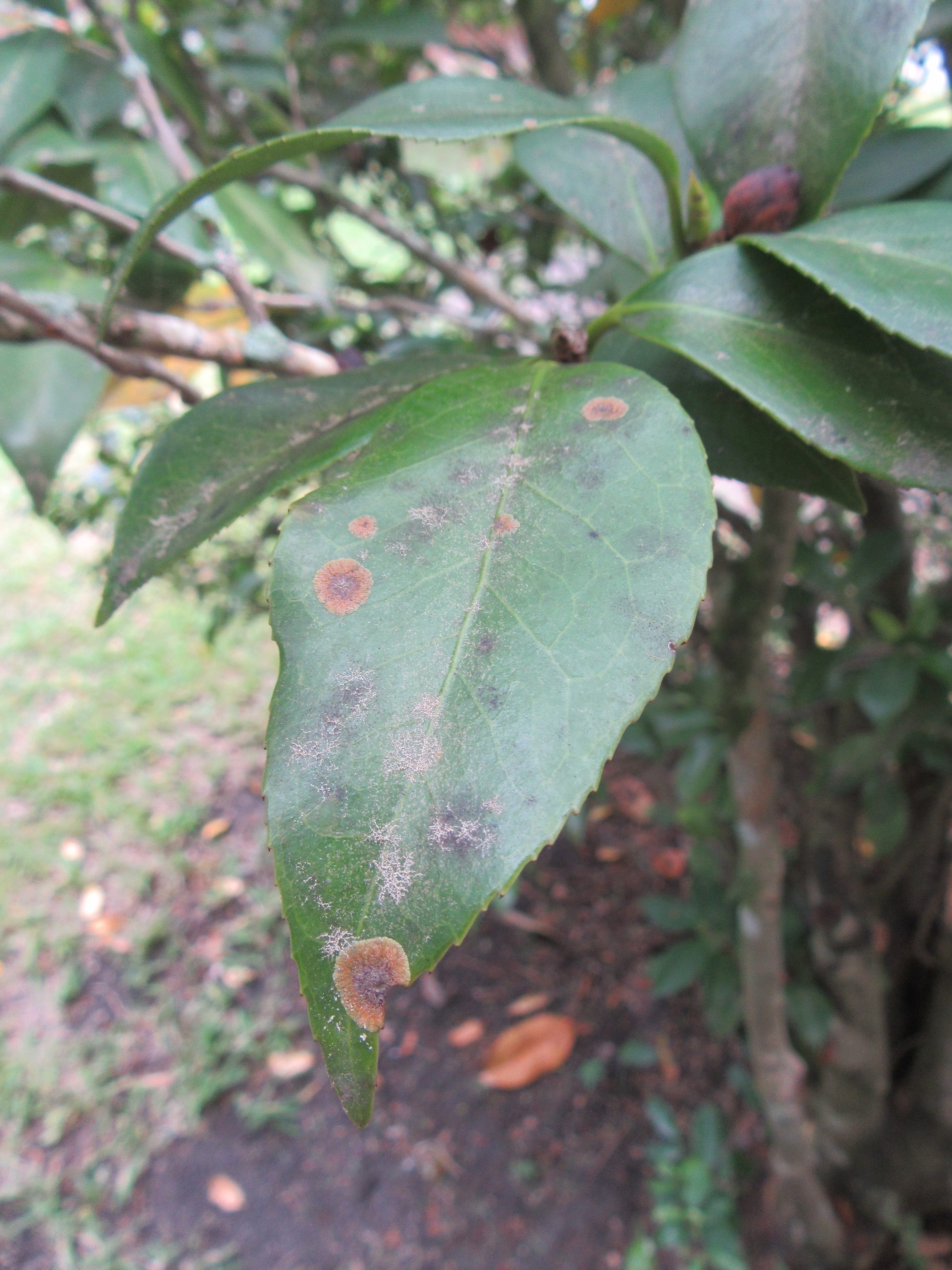
by Matt Lollar | Jun 29, 2017
Algal leaf spot, also known as green scurf, is commonly found on thick-leaved, evergreen trees and shrubs such as magnolias and camellias. It is in the genus Cephaleuros and happens to be one of the only plant parasitic algae found in the United States. Although commonly found on magnolias and camellias, algal leaf spot has a host range of more than 200 species including Indian hawthorn, holly, and even guava in tropical climates. Algal leaf spot thrives in hot and humid conditions, so it can be found in the Florida Panhandle nearly year round and will be very prevalent after all the rain we’ve had lately.
Symptoms
Algal leaf spot is usually found on plant leaves, but it can also affect stems, branches, and fruit. The leaf spots are generally circular in shape with wavy or feathered edges and are raised from the leaf surface. The color of the spots ranges from light green to gray to brown. In the summer, the spots will become more pronounced and reddish, spore-producing structures will develop. In severe cases, leaves will yellow and drop from the plant.
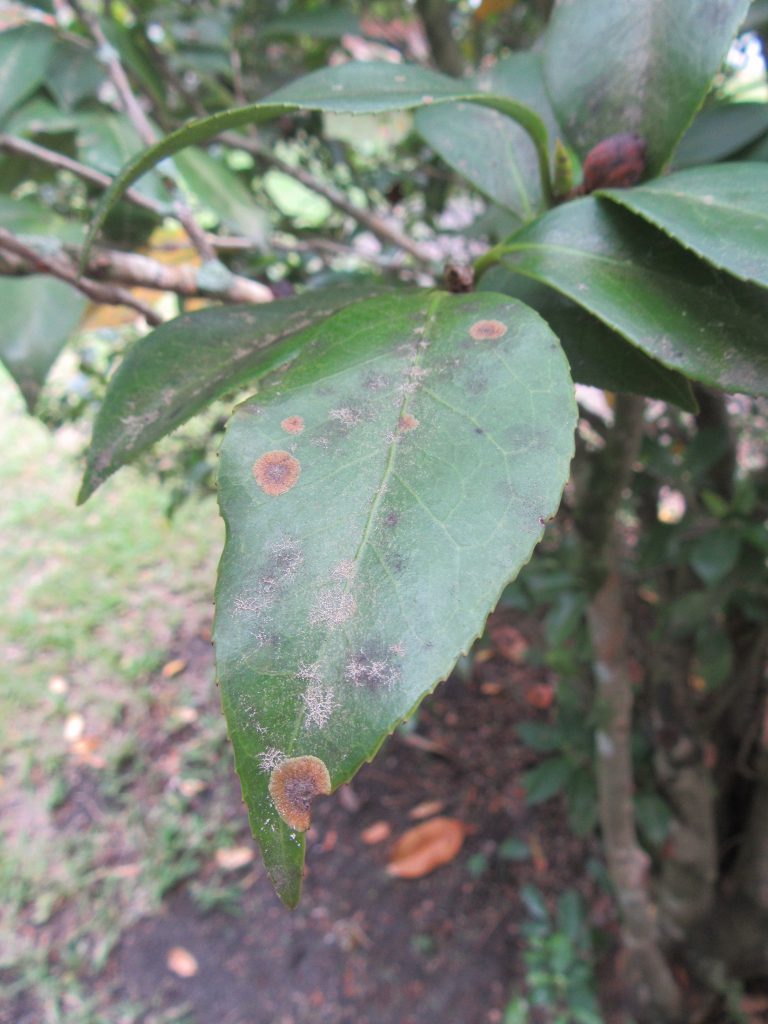
Algal leaf spot on a camellia leaf. Photo Credit: University of Florida/IFAS Extension
The algae can move to the stems and branches in more extreme cases. The algae can infect the stems and branches by entering through a small crack or crevice in the bark. The bark in that area cracks as a canker forms that eventually can girdle the branch, killing it.

Algal leaf spot on a sycamore branch. (Platanus occidentalis). Photo Credit: Florida Division of Plant Industry Archive, Bugwood.org.
Management
In most cases, algal leaf spot is only an aesthetic issue. If only a few leaves are affected, then they can just be removed by hand. \It is important that symptomatic leaves are discarded or composted offsite instead of being left in the mulched area around the trees or shrubs. If symptomatic leaves are left in the same general area then irrigation or rain water can splash the algal spores on healthy leaves and branches. Infected branches can also be removed and pruned.
Preventative measures are recommended for long-term management of algal leaf spot. Growing conditions can be improved by making sure that plants receive the recommended amount of sunlight, water, and fertilizer. Additionally, air circulation around affected plants can be increased by selectively pruning some branches and removing or thinning out nearby shrubs and trees. It is also important to avoid overhead irrigation whenever possible.
Fungicide application may be necessary in severe cases. Copper fungicides such as Southern Ag Liquid Copper Fungicide, Monterey Liqui-Cop Fungicide Concentrate, and Bonide Liquid Copper Fungicide are recommended. Copper may need to be sprayed every 2 weeks if wet conditions persist.
Algal leaf spot isn’t a major pathogen of shrubs and trees, but it can cause significant damage if left untreated. The first step to management is accurate identification of the problem. If you have any uncertainty, feel free to contact your local Extension Office and ask for the Master Gardener Help Desk or your County Horticulture Agent.
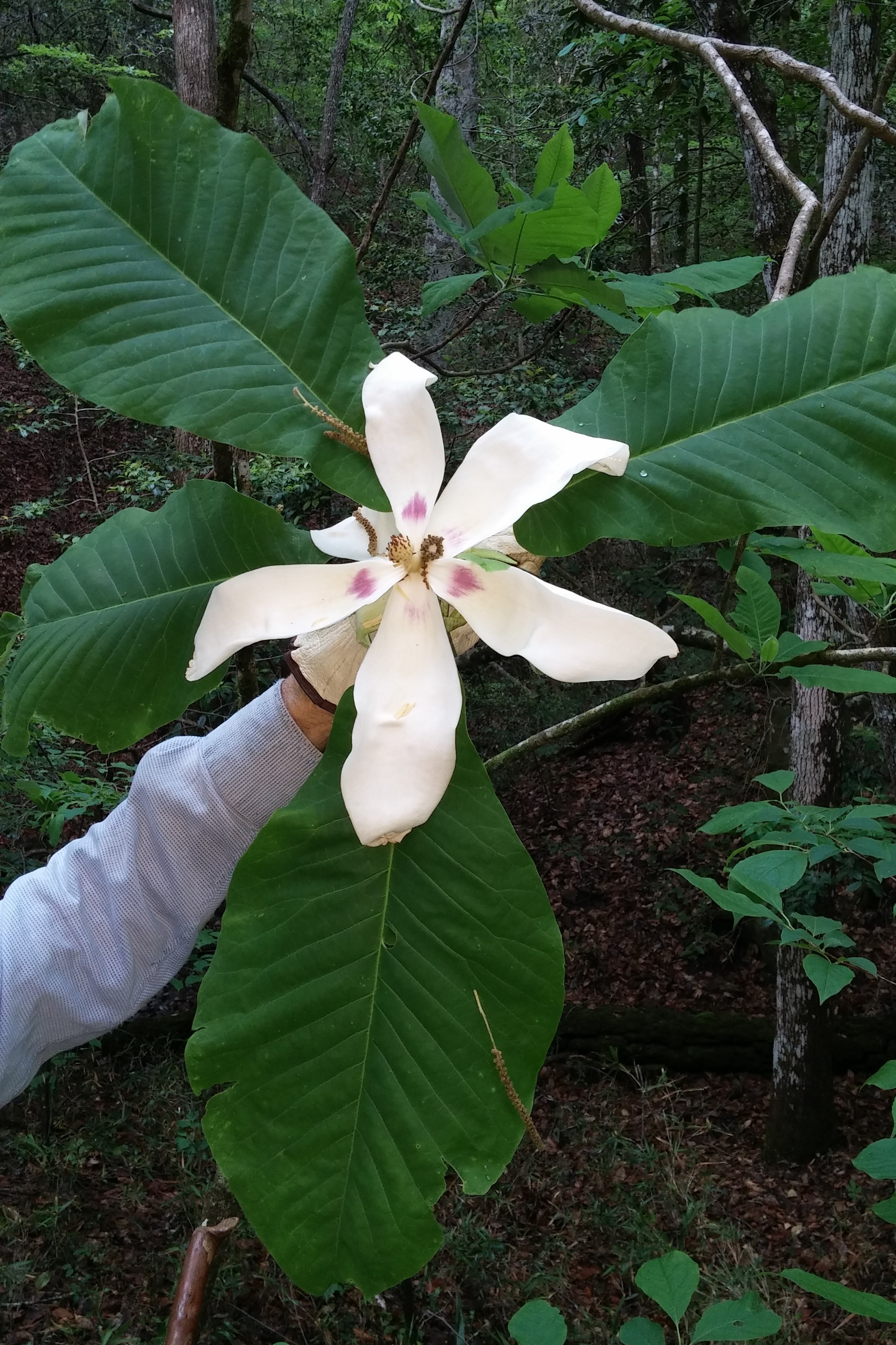
by Gary Knox | Apr 20, 2016
The huge flowers and leaves of Ashe magnolia make it one of my favorite native flowering trees. Individual flowers may be 6 – 12 inches in diameter and are white with purple blotches at the bases of the 3 inner petal-like tepals. When in flower, as they are now in April, the huge white blooms are impossible to miss because of their size and color.
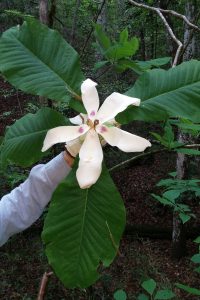
Ashe magnolia. Photo credit: Gary Knox, UF/IFAS.
The leaves are similarly huge, growing 1 – 2 feet long and up to 1 foot across. These large, banana-like leaves offer interest and coarse texture to any landscape.
Ashe magnolia grows as a small tree with a loose, open branching habit up to a height of about 25 feet. The large, light green leaves have whitish undersides and emerge in mid spring prior to flowering. Leaves turn yellowish and fall in autumn, usually without any dramatic color change. Pollinated flowers are followed by reddish, cylindrical, 3-inch fruits producing bright red fleshy seeds in early August.
Native to the Panhandle. This small tree is relatively unknown because of its rarity. Ashe magnolia, Magnolia macrophylla var. ashei, is native in only a few counties in the Florida panhandle and is endangered because of this limited distribution. It is primarily found on the slopes of ravines, growing in the understory of mixed hardwood forest. While it is now illegal to remove this plant or its seeds from the wild, nurseries can grow this plant using seeds from long-cultivated landscape trees.
Garden cultivation. Ashe magnolia makes a lovely small flowering tree if planted in the right location. It grows best in rich, well-drained soil under partial shade, although full sun is tolerated if plants are irrigated during drought. Sheltered sites are best since strong winds can shred the papery leaves and break the brittle branches. You won’t have to wait long for this plant to flower; a unique aspect of Ashe magnolia is that it flowers when young, reportedly when as small as 1 foot tall! Another unusual characteristic is that this Florida native plant is hardy north into USDA plant hardiness zone 6.
Given this species’ beauty, rarity and nativity to the Panhandle, I think it is almost an obligation for panhandle Floridians to cultivate and showcase this plant in our gardens while preserving it in our forests! Seek out specialty nurseries to obtain one of these rare beauties for your garden.
For more information:
Atlas of Florida Plants: Ashe Magnolia
Ashe Magnolia at the United States Botanic Garden
USDA Ashe Magnolia Plant Profile
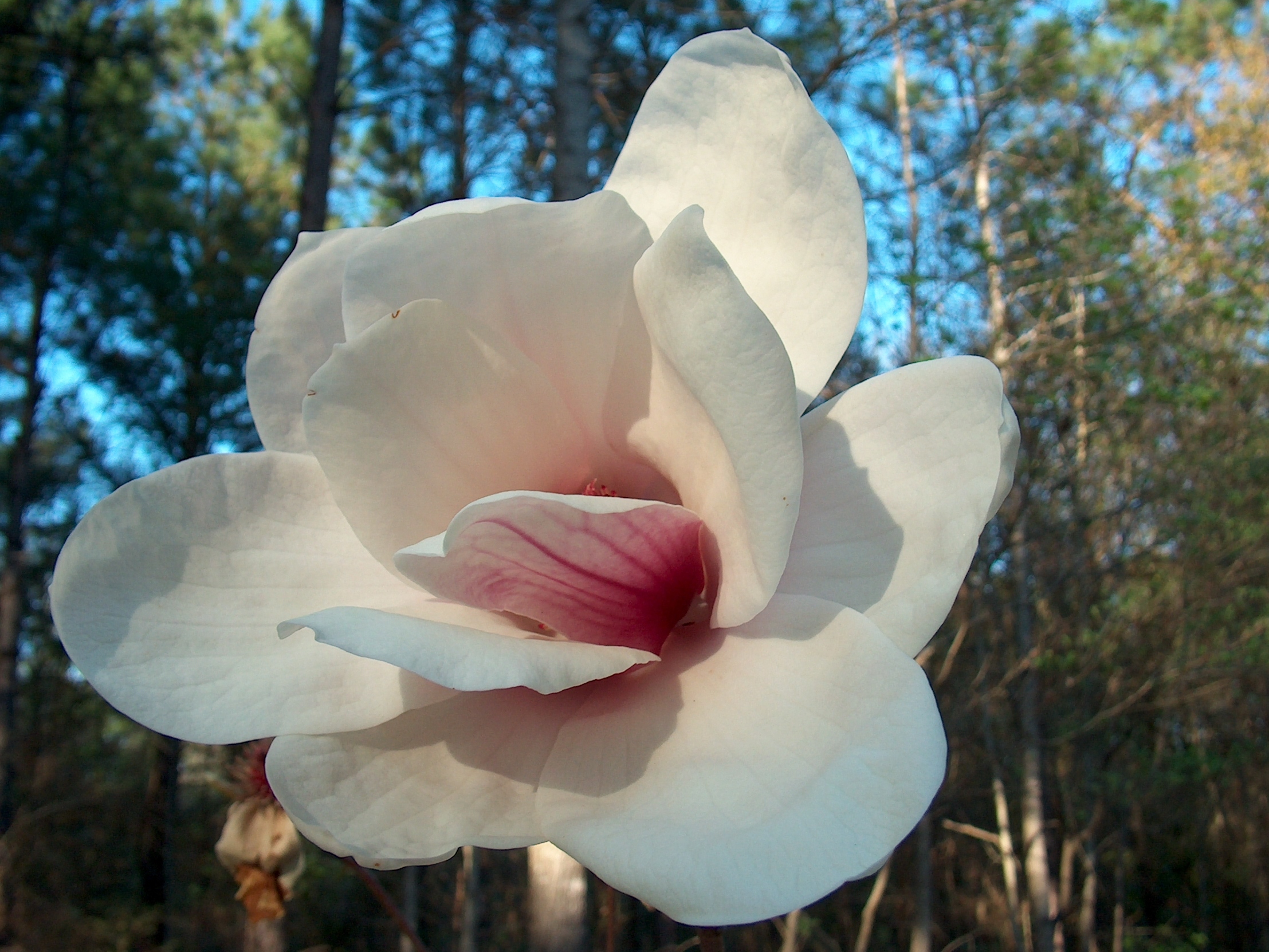
by Gary Knox | Feb 24, 2015
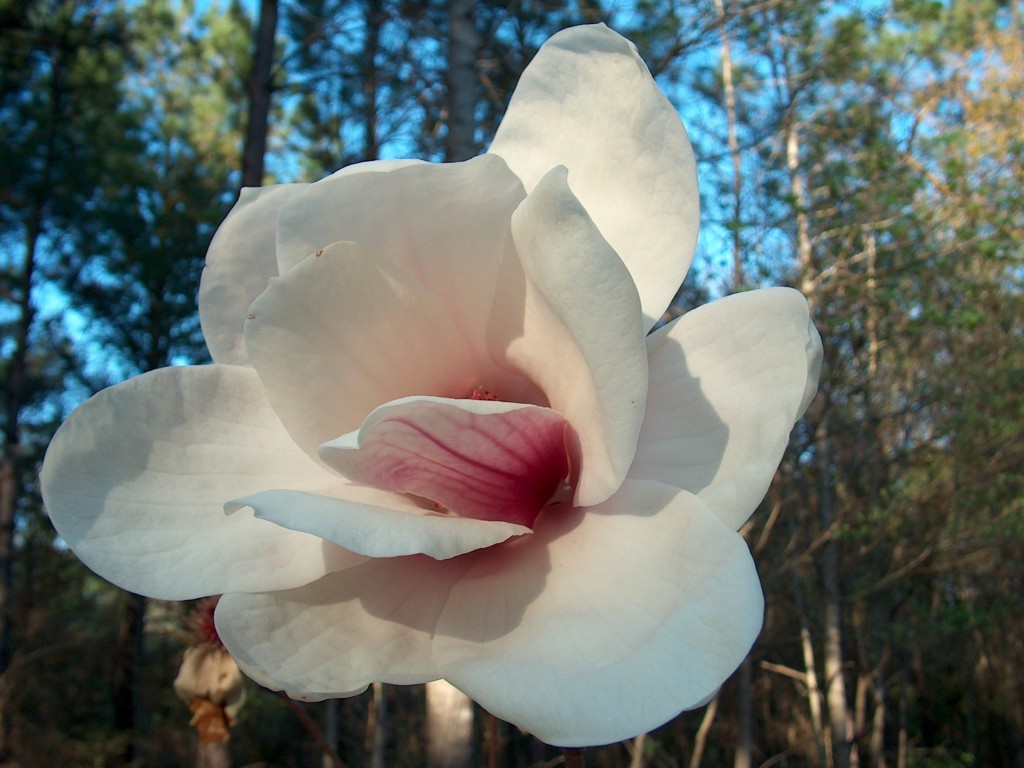
‘Jon Jon’ magnolia
This winter’s recurring freezes and frosts have played havoc with early flowering plants like magnolia. While buds are freeze-resistant, open magnolia flowers can quickly turn brown after exposure to temperatures about 30°F or lower. One way to avoid freeze-damaged flowers is to choose later blooming cultivars. These selections have flowers that open in north Florida during late February or later.
The Magnolia Garden at the University of Florida/IFAS North Florida Research and Education Center (NFREC) in Quincy has more than 150 types of magnolias planted. Based on over 10 years of data, five of the latest blooming magnolias are Daybreak, Jane, Betty, Jon Jon and Ann. These cultivars have peak bloom dates ranging from late February (Ann) to mid-March (Daybreak). Thus, they bloom after most flower-damaging freezes.
Daybreak has beautiful, large shell-pink flowers on a small tree. Jon Jon has huge white flowers with a streak of red-purple at the base. These fragrant flowers open goblet-shaped the first day, and then open wider to a cup-and-saucer shape on subsequent days. At NFREC, Daybreak and Jon Jon have about 6 weeks of flowers and grow as single-stem or multi-stem trees up to about 30 feet tall.
Jane, Betty and Ann are sister cultivars developed at the National Arboretum. As you would expect with sisters, they look-alike, and have a shrubby or multi-stemmed tree habit, generally growing about 15 feet tall and wide (much shorter and wider than Daybreak and Jon Jon). All three have upright, cup-shaped flowers in various shades of pink and red-purple. Betty has medium red-purple flowers that are the largest of the three, over 4 inches. Jane has 3- to 4-inch flowers that are medium pink outside and white or pale pink inside. Ann has the smallest flowers (3 inches) but they are also the darkest red-purple. As an added bonus, Ann boasts the ability to produce sporadic flowers all summer long! This results in Ann having an average of 13 weeks of flowers, as compared to Jane’s 10 weeks and Betty’s 8 weeks.
These five cultivars are generally available at garden centers during spring. Ann and Jane can be found at many “Big Box” stores. All five can be purchased at “good” independent garden centers and, as a last resort, from mail-order/Internet nurseries.
For more information about these and other magnolias, see Florida Extension publication, ‘Jon Jon’ Magnolia: A Late-Flowering Deciduous Magnolia for Northern Florida, and other magnolia publications here. Also, Magnolia Society International is a great resource with a very informative website. (Note the slide show below of Jon Jon, Ann, Betty, Daybreak and Jane.)
[portfolio_slideshow id=4059]














